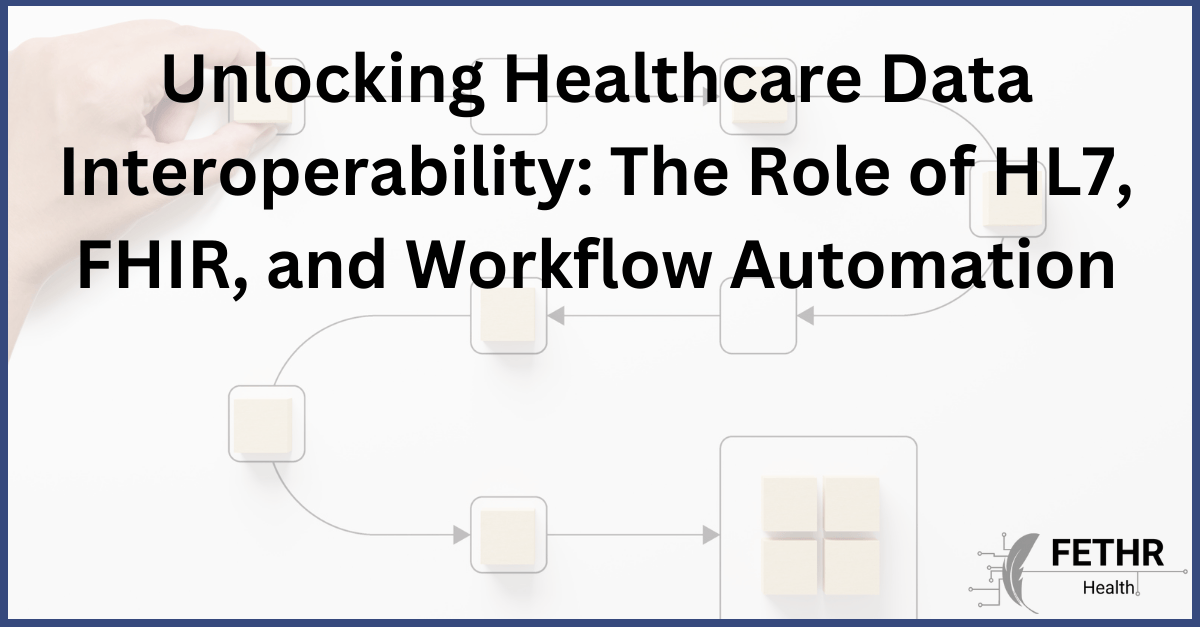In today’s healthcare ecosystem, data is the lifeblood that fuels patient care, operational efficiency, and technological innovation. However, the challenge of connecting disparate systems remains a significant hurdle. According to a 2020 report by the Office of the National Coordinator for Health Information Technology (ONC), only 46% of hospitals reported having necessary patient information available at the point of care from outside providers or sources. This is where healthcare data interoperability becomes crucial. Standards like HL7 and FHIR, coupled with workflow automation on the Fethr Platform, lead the charge in creating seamless communication between healthcare systems.
The Importance of Data Interoperability in Healthcare
Data interoperability refers to the ability of different healthcare information systems to exchange, interpret, and use data coherently. A lack of interoperability can lead to increased healthcare costs. A study published in the Journal of the American Medical Informatics Association estimated that inefficiencies due to interoperability issues cost the U.S. healthcare system over $30 billion annually.
In an era where patient care often involves multiple providers and specialists, seamless access to accurate, real-time information is critical. Interoperability ensures that care teams have all the necessary information at the point of care, leading to better clinical decisions, improved patient safety, and a more efficient healthcare system.
The HL7 Standard: The Backbone of Healthcare Data Exchange
One of the most widely used standards for healthcare data exchange is HL7 (Health Level Seven International). Established in the 1980s, HL7 was designed to facilitate the structured and standardized exchange of information between healthcare systems. Today, over 95% of U.S. healthcare organizations use some form of HL7 standards.
HL7 messages are pipe-delimited files where each field is separated by a vertical bar (|). This structure ensures consistent data transmission, making it easier for systems to interpret and process information. For example, a specific field in an HL7 message always represents the patient's name, while another always represents their date of birth.
Despite its widespread adoption, HL7 has limitations. It was designed for older technologies and operates over TCP/IP connections. Data exchange using HL7 can be cumbersome, especially in modern environments that rely on cloud-based and API-driven technologies. Moreover, HL7 lacks native encryption, requiring VPNs to secure sensitive patient information.
FHIR: The Modern Standard for Healthcare Interoperability
Recognizing the need for a more flexible solution, the healthcare industry has turned to FHIR (Fast Healthcare Interoperability Resources). Developed by HL7 International, FHIR offers a modern approach using web-based technologies. According to a 2021 survey by HIMSS, over 70% of healthcare IT professionals are either implementing or planning to implement FHIR standards.
FHIR leverages widely accepted web standards like RESTful APIs, JSON, and XML, making healthcare data more accessible and easier to integrate with modern applications. RESTful APIs are one of its most significant advantages, allowing quick and simple integration between systems. This is especially useful for mobile applications, telemedicine solutions, and cloud-based platforms where real-time data access is critical.
While FHIR is gaining momentum, full adoption is still in progress. Many electronic health records (EHR) systems are slow to implement FHIR due to the complexities of transitioning from legacy systems and associated costs. However, regulatory mandates like the 21st Century Cures Act push organizations to adopt more modern interoperability solutions.
The Hybrid Approach: Leveraging HL7 and FHIR Together
Many systems still rely on HL7, so a hybrid approach is often necessary. In many cases, HL7 is used for real-time data exchange between EHR systems, while FHIR is employed to pull additional data or support modern applications. For instance, an organization might use HL7 for exchanging admission, discharge, and transfer (ADT) messages in real time while using FHIR to retrieve patient data for mobile health apps.
The Role of Workflow Automation in Healthcare Interoperability
Workflow automation plays a pivotal role in managing the flow of data. By automating repetitive tasks, organizations can reduce manual interventions and minimize errors. A report by McKinsey & Company states that automating data management processes can reduce operational costs by up to 30%.
For example, automation can trigger an HL7 message automatically when a patient is admitted, ensuring immediate data dissemination to relevant systems. Similarly, FHIR-based APIs can fetch the latest patient data when a doctor accesses a health record—if it is tied to a workflow.
The Cost of Not Implementing Interoperability and Automation
Failing to implement interoperability and automation comes at a high cost. According to Westthe Health Institute, the lack of interoperability costs the U.S. healthcare system over $150 billion annually due to inefficiencies, redundant testing, and administrative burdens. Without these systems, organizations face data silos and miscommunications that can lead to suboptimal patient care and compliance risks.
Fethr Health’s Approach to Streamlining Interoperability
At Fethr Health, we understand these challenges. That's why we've built a platform that merges the power of both HL7 and FHIR, offering a seamless integration experience without extensive coding. With pre-built connections to popular EHR systems like Epic and Cerner, Fethr Health allows organizations to integrate healthcare data quickly and efficiently.
Our platform also offers workflow automation tools that empower organizations to move faster. Whether you're looking to exchange data in real-time, automate patient workflows, or enable mobile health applications, Fethr Health provides the tools to simplify the process.
Conclusion
Achieving seamless data interoperability is essential for modern healthcare. HL7 and FHIR offer potent solutions for data exchange, but combining these standards with workflow automation is transformative. Healthcare organizations can improve data exchange, enhance operational efficiency, and ultimately provide better patient care by adopting a hybrid approach and leveraging automation tools.
As healthcare evolves, data interoperability will become even more critical. Organizations that embrace these standards and technologies today will be well-positioned to meet the challenges of tomorrow.

